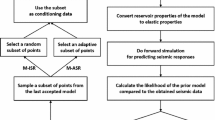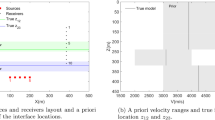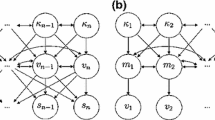Abstract
The paper discusses the performance and robustness of the Bayesian (probabilistic) approach to seismic tomography enhanced by the numerical Monte Carlo sampling technique. The approach is compared with two other popular techniques, namely the damped least-squares (LSQR) method and the general optimization approach. The theoretical considerations are illustrated by an analysis of seismic data from the Rudna (Poland) copper mine. Contrary to the LSQR and optimization techniques the Bayesian approach allows for construction of not only the “best-fitting” model of the sought velocity distribution but also other estimators, for example the average model which is often expected to be a more robust estimator than the maximum likelihood solution. We demonstrate that using the Markov Chain Monte Carlo sampling technique within the Bayesian approach opens up the possibility of analyzing tomography imaging uncertainties with minimal additional computational effort compared to the robust optimization approach. On the basis of the considered example it is concluded that the Monte Carlo based Bayesian approach offers new possibilities of robust and reliable tomography imaging.












Similar content being viewed by others
References
Aki, K. and Richards, P.G., Quantitative Seismology (Freeman and Co, San Francisco 1985).
Backus, G. and Gilbert, F. (1970), Umiqueness in the inversion of inaccurate gross earth data, Phil. Trans. Roy. Soc. Lond. 266:123–192.
Bosch, M. (1999), Lithologic tomography: From plural geophysical data to lithology estimation, J. Geophys. Res. 104, 749–766.
Bosch, M., Barnes, C., and Mosegaard, K. Multi-step samplers for improving efficiency in probabilistic geophysical inference.In: Methods and Application of Inversion (eds. P. C. Hansen, B. H. Jacobsen, K. Mosegaard) (Springer, Berlin 2000), vol. 92 of Lecture Notes in Earth Sciences, pp. 50–68.
Brandt, S., Data Analysis. Statistical and Computational Methods for Scientists and Engineers. (Springer-Verlag 1999), third ed.
Cardarelli, E. and Cerrto, A. (2002), Ray tracing in elliptical anisotropic media using the linear traveltime interpolation (LTI) method applied to traveltime seismic tomography, Geophys. Prosp. 50, 55–72.
Casella, R., Monte Carlo Statistical Methods, Springer Texts in Statistics. Springer-Verlag, New York 1999).
Claerbout, J.F., Imaging the Earth’s Interior. (Blackwell Sci. Publ., Boston 1985).
Curtis, A. and Lomax, A. (2001), Prior information, sampling distributions and the curse of dimensionality, Geophysics 66, 372–378.
Dȩbski, W. (1997a), The probabilistic formulation of the inverse theory with application to the selected seismological problems, Publs. Inst. Geophys. Pol. Acad. Sc. B19, 1–173.
Dȩbski, W. Study of the image reconstruction accuracy of active amplitude tomography, in: Rockburst and Seismicity in Mines (eds. S. J. Gibowicz and S. Lasocki) (Balkema, Postbus 1675, Rotterdam, Nederland 1997b), pp. 141–144.
Dȩbski, W. (2002), Seismic tomography software package, Publs. Inst. Geophys. Pol. Acad. Sci. B-30, 1–105.
Dȩbski, W. (2004), Application of Monte Carlo techniques for solving selected seismological inverse problems, Publs. Inst. Geophys. Pol. Acad. Sci B-34, 1–207.
Dȩbski, W. (2008), Estimating the earthquake source time function by Markov Chain Monte Carlo sampling, Pure Appl. Geophys. 165:1263–1287. doi:10.1007/s00024-008-0357-1.
Dȩbski, W. and Young, R.P. (2002), Tomographic imaging of thermally induced fractures in granite using Bayesian inversion, Pure Appl. Geophys. 159, 277–307.
Dȩbski, W., Guterch, B., Lewandowska, H., and Labak, P. (1997), Earthquake sequences in the Krynica region, Western Carpathians, 1992 – 1993, Acta Geophys. Pol. XLV, 255–290.
Deal, M. Nolet, G. (1996), Comment on ‘Estimation of resolution and covariance for large matrix inversions‘ by Zhang J. and McMechan G, Geophys. J Int 127, 245–250.
Deans, S. R., The Radon Transform and Some of Its Applications (John Wiley and Sons, New York 1983).
Duijndam, A. (1988), Bayesian estimation in seismic inversion. part II: Uncertainty analysis, Geophys. Prosp. 36, 899–918.
Gamerman, D. Markov Chain Monte Carlo: Stochastic Simulation for Bayesian Inference. (Chapman and Hall 1997).
Gelman, A., Carlin, J.B., Stern, H.S., Rubin, D. B., Bayesian Data Analysis (Chapmann & Hall 1997).
Gilks, W., Richardson, S., Spiegelhalter, D., Markov Chain Monte Carlo in Practice (Chapman& Hall/CRC Press 1995).
Gillespie, D. T. Markov Processes - An Introduction for Physical Scientists. (Academic Press, Inc., San Diego 1992).
Hastings, W. K. (1970), Monte Carlo sampling methods using Markov chains and their applications, Biometrica 57, 97–109.
Iyer, H. Hirahara, K., Seismic Tomography, Theory and Practice (Chapman and Hall, London 1993).
Jackson, D. D. and Matsu’ura, M. (1985), A Bayesian approach to nonlinear inversion, J. Geophys. Res. 90, 581–591.
Jeffreys, H. Theory of Probability (Clarendon Press, Oxford 1983).
Kijko, A. (1994), Seismological outliers: L1 or adaptive Lp norm application, Bull. Seismol. Soc. Am. 84, 473–477.
Limes, L. R. and Treitel, S. (1983), Tutorial, a review of least-squares inversion and its application to geophysical problems, Geophys. Prospect. 32, 159–186.
Lomax, A., Virieux, J., Volant, P., Berge, C. Probabilistic earthquake location in 3D and layered models: Introduction of a Metropolis-Gibbs method and comparison with linear location. In: Advances in Seismic Event Location (eds C. Thurber, E. Kissling, and N. Rabinovitz) (Kluwer, Amsterdam 2000).
Maxwell, S. C. Young, R. P. (1993), A comparison between controlled source and passive source seismic velocity images, Bull. Seismol. Soc. Am. 83, 1813–1834.
Menke, W. Geophysical Data Analysis: Discrete Inverse Theory, International Geophysics Series (Academic Press, San Diego 1989).
Metropolis, N., Rosenbluth, A., Rosenbluth, M., Teller, A., and Teller, E .(1953), Equation of state calculations by fast computing machines, J. Chem. Phys. 21, 1087–1092.
Michalewicz, Z. Genetic Algorithms + Data Structures = Evolution Programs. (Springer-Verlag, Berlin 1996).
Mosegaard, K. and Tarantola, A. (1995), Monte Carlo sampling of solutions to inverse problems, J. Geophys. Res. 100, 12431–1247.
Mosegaard, K., and Tarantola, A. International Handbook of Earthquake & Engineering Seismology, (Academic Press 2002), chap. Probabilistic Approach to Inverse Problems, pp. 237–265.
Nolet, G. Seismic Tomography (D. Reidel Publishing Company, Dordrecht 1987).
Nolet, G., Montelli, R., and Virieux, J. (1999), Explicit, approximate expressions for the resolution and a posteriori covariance of massive tomographic systems, Geophys. J. Int. 138, 36–44.
Nolet, G., Montelli, R., and Virieux, J. (2001), Replay to comment by Z. S. Yao and R. G. Roberts and A. Tryggvason on ‘Explicit, approximate expressions for the resolution and a posteriori covariance of massive tomographic system’, Geophys. J. Int. 145, 315.
Parker, R. L. Geophysical Inverse Theory (Princeton University Press, New Jersey 1994).
Robert, C. P. and Casella, G. Monte Carlo Statistical Methods (Springer Verlag 1999).
Sambridge, M. (1999) Geophysical inversion with a neighbourhood algorithm - I. Searching a parameter space, Geophys. J. Int. 138, 479–494.
Sambridge, M. and Mosegaard, K. (2002), Monte Carlo methods in geophysical inverse problems, Rev. Geophys. 40, 3.1–3.29.
Sambridge, M. S. and Kennett, B. L. N. (2001), Seismic event location: Nonlinear inversion using a Neighbourhood Algorithm, Pure Appl. Geophys. 158, 241–257.
Scales, J. A. Uncertainties in seismic inverse calculations. In: Inverse Methods Interdisciplinary Elements of Methodology, Computation, Application (eds B. H. Jacobsen, K. Moosegard, and P. Sibani) (Springer-Verlag, Berlin 1996), vol. 63 of Lecture Notes in Earth Sciences, pp. 79–97.
Scales, J. A. and Snieder, R. (1997), To Bayes or not to Bayes? Geophysics 63, 1045–1046.
Sen, M. and Stoffa, P. L., Global Optimization methods in Geophysical Inversion, vol. 4 of Advances in Exploration Geophysics (Elsevier, Amsterdam 1995).
Tarantola, A., Inverse Problem Theory: Methods for Data Fitting and Model Parameter Estimation, (Elsevier, Amsterdam 1987).
Tarantola, A., Inverse Problem Theory and Methods for Model Parameter Estimation (SIAM, Philadelphia 2005).
Tarantola, A. and Vallete, B. (1982), Inverse Problems = Quest for Information, J. Geophys. 50, 159–170.
Taylor, S. R., Yang, X., and Philips, S. (2003), Bayesian l g attenuation tomography applied to Eastern Asia, Bull. Seismol. Soc. Am. 93, 795–803.
Tierney, L. (1994), Markov chains for exploring posterior distributions, Ann. of Stat. 22, 1701–1762.
Van Kampen, N., Stochastic Processes in Physics and Chemistry (Elsevier 1992).
Wiejacz, P. and Dȩbski, W. (2001), New observation of Gulf of Gdansk Seismic Events, Phys. Earth Planet Int. 123, 233–245.
Yao, Z. S., Roberts, R. G., and Tryggvason, A. (1999) Calculating resolution and covariance matrices for seismic tomography with the LSQR method, Geophys. J. Int. 138, 886–894.
Yao Z. S., Roberts, R. G., Tryggvason, A. (2001) Comment on ‘Explicit, approximate expressions for the resolution and a posteriori covariance of massive tomographic system’ by G. Nolet, R. Montelli and J. Virieux, Geophys. J. Int. 145, 307–314.
Zhang, J. McMechan, G. (1996), Replay to comment by M. Deal and G. Nolet on ‘Estimation of resolution and covariance for large matrix inversions‘, Geophys. J. Int. 127, 251–252.
Zhao, D. (2001), New advances of seismic tomography and its applications to subduction zones and earthquake fault zones: A review, The Island Arc 10, 68–84.
Acknowledgments
I would like to thank Prof. S. J. Gibowicz for years of very fruitful collaboration, many interesting discussions and all the assistance he has given me. C. Trifu, the editor of this special issue, and the anonymous reviewers are acknowledged for their efforts in significantly enhancing the paper. This work was partially supported by the Polish Committee for Scientific Research under Grant No. 2P04D 033 30.
Author information
Authors and Affiliations
Corresponding author
Rights and permissions
About this article
Cite this article
Dȩbski, W. Seismic Tomography by Monte Carlo Sampling. Pure Appl. Geophys. 167, 131–152 (2010). https://doi.org/10.1007/s00024-009-0006-3
Received:
Revised:
Accepted:
Published:
Issue Date:
DOI: https://doi.org/10.1007/s00024-009-0006-3




